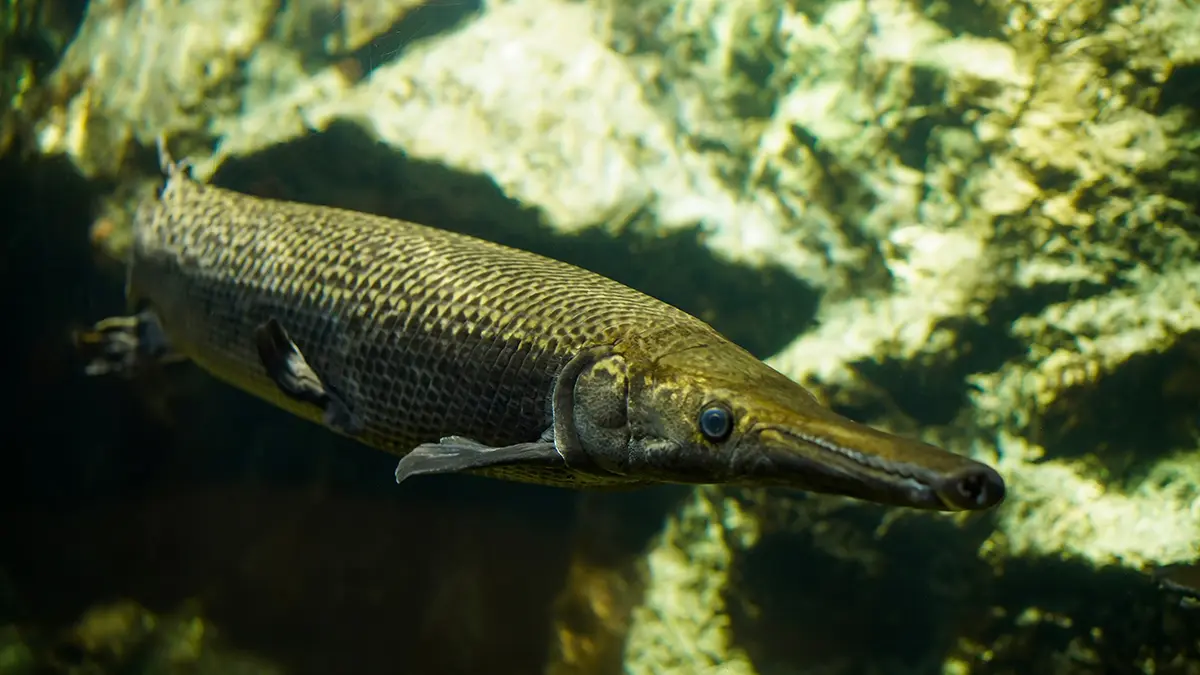A prehistoric beast or a gentle giant, biologists across the country have worked hand in hand with trophy gar anglers for the past decade to help soften the toothy fish’s reputation. As the appetite for alligator conservation grows, so does the research into what makes them so important to fisheries. This article about alligator gar serves as a comprehensive species guide, and was developed to ensure you know as much about alligator gar as you do your favorite sport fish.
ALLIGATOR GAR HISTORY
The alligator gar (Atractosteus spatula) and six other gar species are part of the Lepisosteidae family. It is the largest of the seven species and the second-largest freshwater fish in the United States. The name spatula comes from the Greek word spathe, which means spoon, flat blade, or a tool with a flat surface. It was given to the fish because of its flat, compact snout. This ancient fish has been named a “living fossil” due to its long history on Earth, specifically in the Americas. The species has been traced back to living 100 million years ago, and some fossils date back to 215 million years.
The alligator gar takes on multiple common names like gator gar, gator, garfish, garpike, and greater gar.
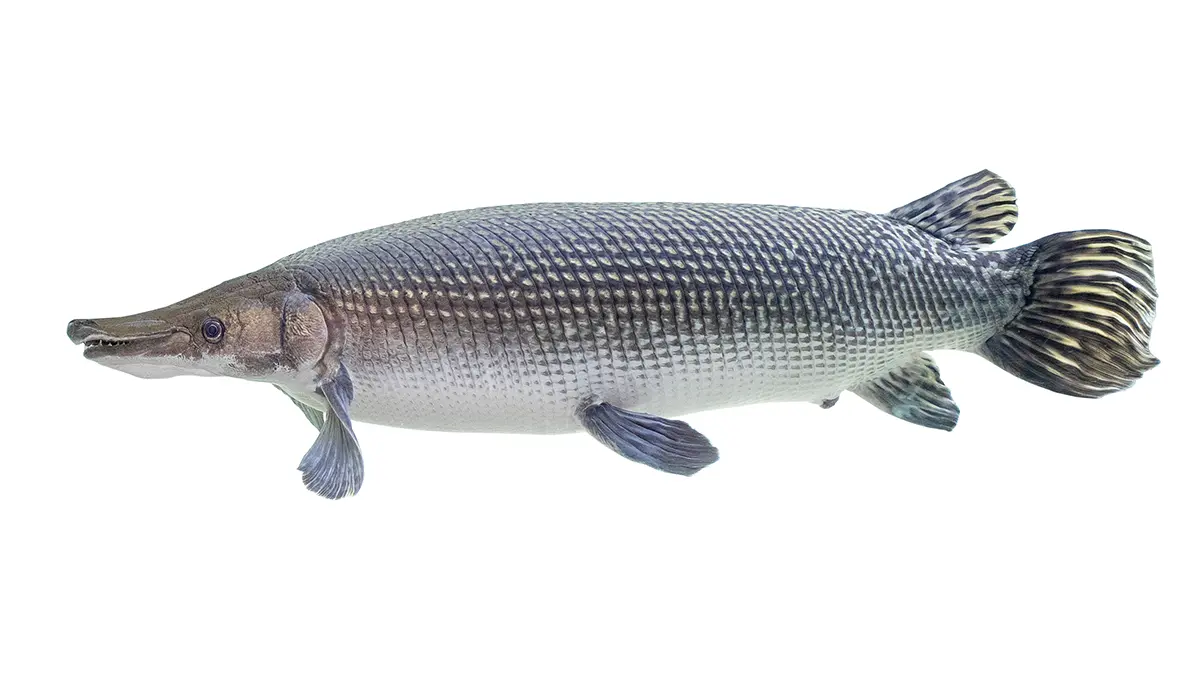
ALLIGATOR GAR IDENTIFICATION
Identifying alligator gar can sometimes be challenging due to their related gar species; the three most common are the spotted gar, longnose gar, and shortnose gar. While all seven species have some essential characteristics, here are some key ways to correctly identify the alligator gar.
Alligator gar are usually a light brown to olive green, with shiny diamond-shaped ganoid scales, and spots mainly on the tail and fins. The younger gar usually has a dashed pattern along the side of the body, but as the fish grows and matures, these markings tend to fade. Their primary body color will also start as a bronze or brown color before slowly turning into a lighter greenish-gray as they grow. If you count the scales down the lateral line, you should see 58 to 62. The dorsal fin is located at the back of the fish near the caudal tail and will have 7 to 10 soft rays. The anal fin is almost mirror to the dorsal, residing at the base of the tail and also contains 7 to 10 soft rays. They have an extended tubular body profile with a broad snout that is characteristically more flattened than the other gar species. Their snout has two rows of teeth on the upper jaw, unlike other gars with just one row. Gar teeth are long and more needle-like than most other freshwater fish teeth. They are not afraid to use them, so use caution when handling them.
Alligator gar are the second largest freshwater fish in the U.S., only to the sturgeon, and the largest of the gar species. They can grow up to 10 feet long and have been recorded weighing as much as 327 pounds. If you reel in a gar over 6.5 feet long, it is likely an alligator gar. The alligator gar is often confused with fish in the pike family, such as the northern pike or musky. However, if you catch one of these fish and are unsure, look at the fish’s tail. Gar will have a rounded tail fin, while pike will always have a forked tail. All gar species also have diamond-shaped ganoid scales that interlock into a very tough protective layer.
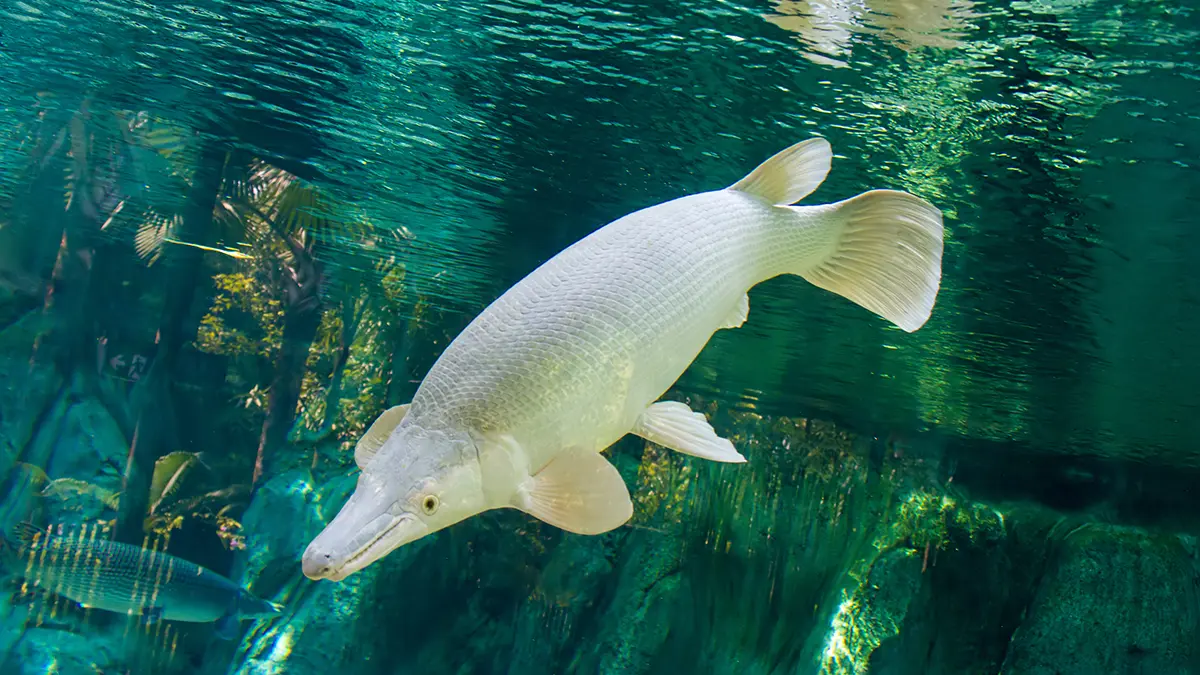
ALLIGATOR GAR LOCATION
Alligator gars are found in the southern United States, with some of the most vital populations in Texas. Almost every Texas river draining into the Gulf of Mexico contains gator gars. Their native range extends explicitly from the Econfina River in Florida, southwestern down the coast, to Veracruz, Mexico.
Due to habitat loss, specifically the floodplains used to spawn, the alligator gar’s range has become considerably smaller. Historically, these fish had healthy populations extending up the Mississippi River basin as far as the Missouri and Ohio River systems. There are still some possible sightings of alligator gar in some of these northern systems, but they are scientifically unconfirmed and rare.
There are also some invasive populations of alligator gar outside the southern U.S. The pet fish trade has moved these gar into many systems in mainland China. The lack of natural predators has allowed for overgrown populations and troubled ecosystems. California has also had few confirmed catches and sightings. This is also most likely due to aquarium-grown fish released into non-native waters.
ALLIGATOR GAR SPAWNING
Alligator gar are a long-living species that grow and mature slowly. Males usually take about five years to mature, while females take about ten years. Spawning begins in the spring when water temperatures reach 68 degrees Fahrenheit. The seasonal rains between late April and June are crucial to spawning, as they can bring the freshly flooded vegetation alligator gar need. If both conditional needs are met, the male gar will move into the shallow water, twisting and bumping into the females. This triggers the release of the eggs from the female, which the male quickly fertilizes. The eggs are red and, once fertilized, stick to the vegetation around them. The number of eggs laid depends on the size of the female, but biologists have set averages around 140,000 eggs per female.
The alligator gar spawning process requires a flooded marsh-like habitat, and due to water usage and drought, their population has continued to decline in recent years. Alligator gar specifically are so reliant on these flood waters that they have been estimated to now only have the opportunity to spawn a few times during their lives.
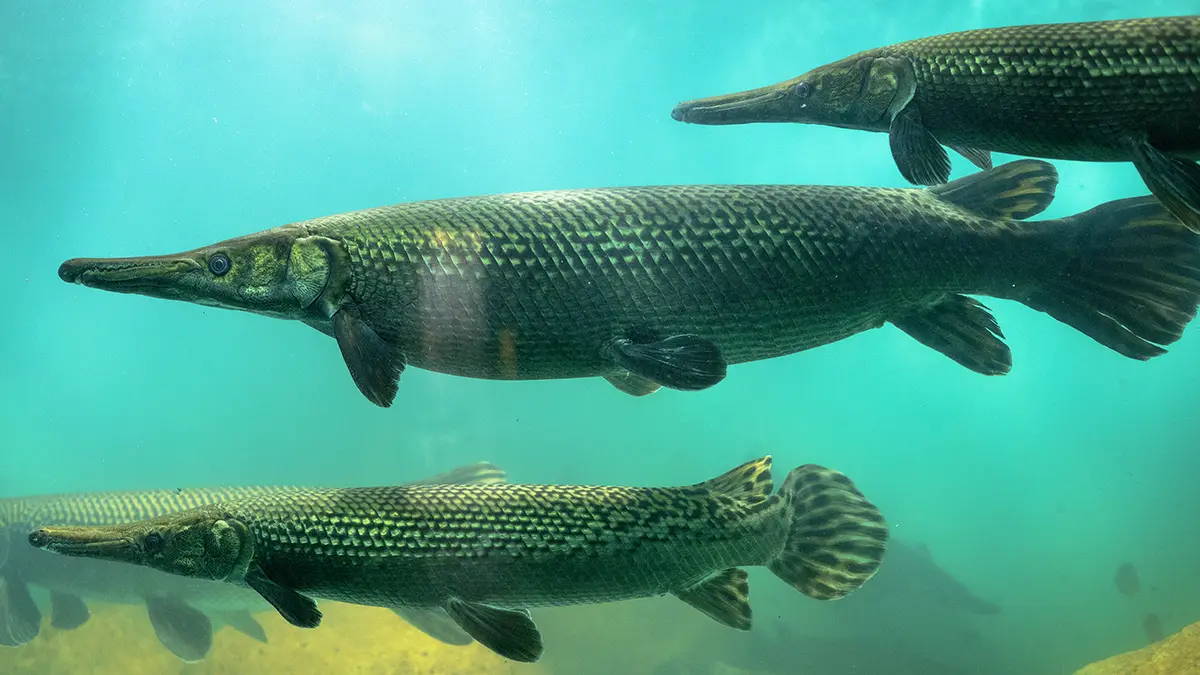
ALLIGATOR GAR SIZE AND LIFESPAN
After laying eggs, the fry will hatch within a few days based on water temperature. Once hatched, they feed on the yolk sac still attached to their body. Newborn fry have a slight sticky disc on the bottom of their head that lets them stay attached to vegetation while they grow. After a few days, the fish detaches and becomes free swimming. At this time, they feed on small insects and other invertebrates. They soon add small fish to their diet, allowing them to grow much faster. Juvenile alligator gar will feed heavily on shad species, juvenile carp, and suckers.
The juvenile gar’s initial growth spurt is short-lived, and growth rates slow down quite a bit. As they grow, they primarily eat large fish such as carp and buffalo. If given enough time, an alligator gar that makes it past the juvenile stages can easily reach sizes near 6.5 feet and 100 pounds. Some water systems will produce an abundance of trophy fish that are 7 feet and longer, and some of the longest-living fish can reach sizes of 10 feet and 300 pounds.
Adult fish live anywhere from 30 to 50 years in the wild, with females typically living longer than males. Some fish can pass this threshold and reach ages double the average.

ALLIGATOR GAR HABITAT
Alligator gar are versatile when it comes to preferred habitats and their quality. They are found in slow rivers, lakes, reservoirs, bayous, and even brackish bays where freshwater systems meet the ocean. Alligator gar are the most tolerant gar species to salt water. While they don’t particularly prefer salty water conditions, they are willing to move into these areas for food or good spawning territory. Generally, these alligator gar will hang out in shallow, warm water areas with vegetation. They are lie-and-wait ambush predators, meaning they float and wait or slowly drift through open waters, waiting for food to move within their reach.
Alligator gar can temporarily live in poor water quality as they can partially breathe oxygen from the air. Gar have specialized air bladders in their bodies that can process small amounts of oxygen into the bloodstream from the atmosphere while also using their gills. If an alligator gar slowly breaches the surface, they probably take a small gulp of air. Having this ability enables them to live in low dissolved oxygen water conditions. They can also be found in an extensive range of water clarities and are commonly found in muddier or more tinted water.
Alligator gar prefer large river systems with slow-moving water. The prime spawning habitat is shallow, with flooded vegetation in water above 68 degrees, so these large river systems with lots of floodplain areas are perfect. The creation of dams and water flow restrictions in many places have dropped water levels and taken away much of this prime spawning habitat.
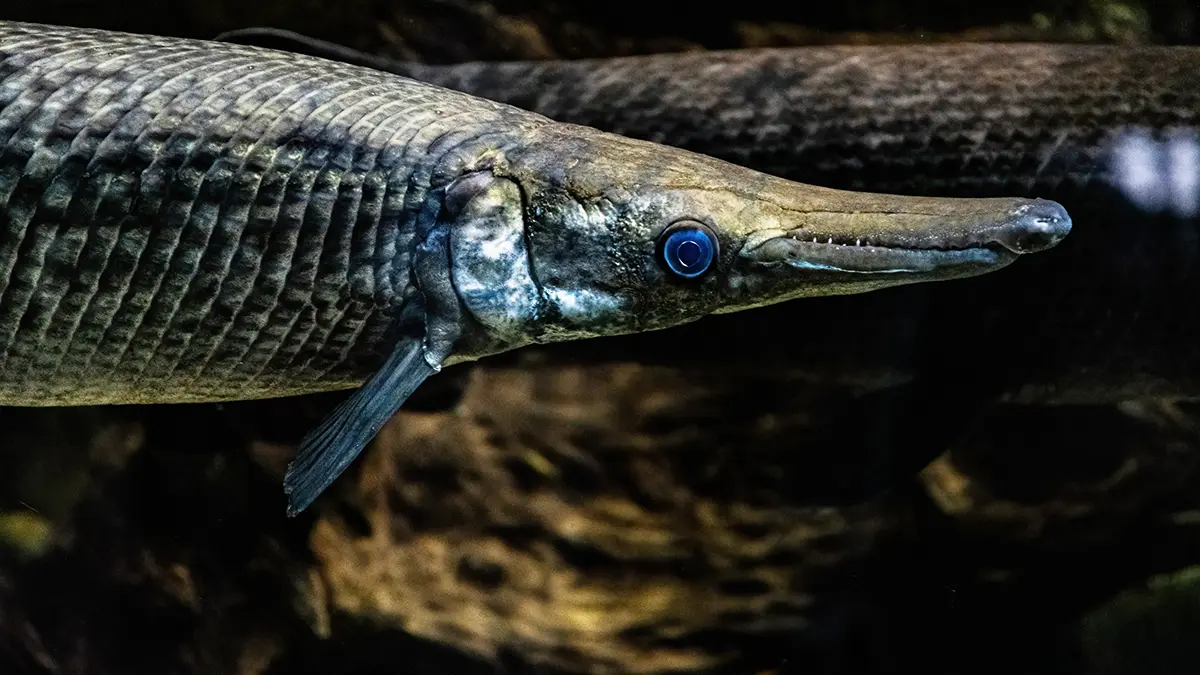
ALLIGATOR GAR DIET
Alligator gar are well known for their large size and seemingly scary presence. They are a ravenous predator when feeding but are relatively passive creatures. Gar primarily feed on common fish species such as carp, buffalo, shad, and sometimes game fish crappie. They are also sometimes seen feeding on non-fish species such as rodents, birds, and turtles. The size of food heavily depends on the gar’s size but is always consumed whole. When living in brackish water systems, they have been known to feed on crustaceans, such as crabs, quite heavily.
When hunting for food, alligator gar uses the lie-and-wait ambush technique. Their streamlined body and large tail fins allow them to lunge at quick speeds rather than fast, constant speeds. They also prefer to feed undetected at night rather than in the light of day. Their sharp teeth are used more to capture and hold prey but not remove parts of prey.
ALLIGATOR GAR THREATS
Over recent decades, the alligator gar had a poor reputation, earning the nickname “trash fish.” Overfishing, removal efforts, and lack of management have all directly affected this reputation, leading to the loss of many populations in areas now not described under the native range. The specific spawning requirements also challenge the conservation of alligator gar. Disruption of water flow from damming or other developmental projects has gradually dropped water levels in both rivers and reservoirs, leaving crucial floodplains and vegetation out of reach. Luckily, multi-species angling and native fish anglers have brought a new sense of importance to the conservation of the species. In recent years, managers have begun working much harder to educate the public on the importance of native alligator gar and the balance they bring to natural environments.

FACTS YOU NEED TO KNOW
- The red eggs of female alligator gar are poisonous and can cause health issues if ingested.
- The IGFA World Record for alligator gar is 283 pounds and was caught Sept. 2nd 2023 by Arthur Weston at Sam Rayburn Lake in Texas.
- The largest gar ever recorded was 327 pounds and 8.5 feet long; it was caught Feb 14th 2011 by a commercial fisherman named Kenny Williams at Lake Chotard MS.
- Alligator gar are the state primitive fish of Arkansas.


